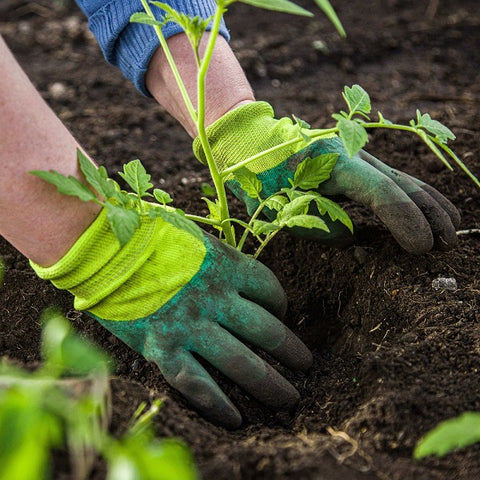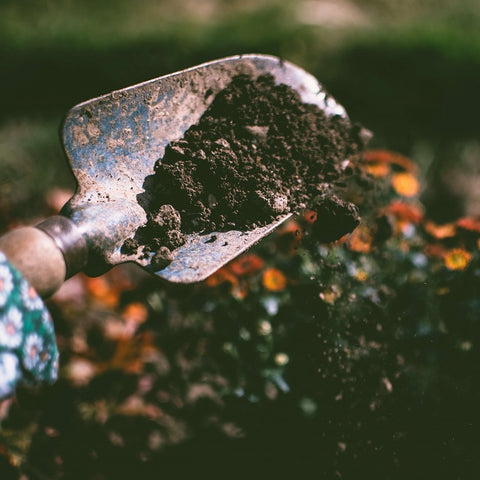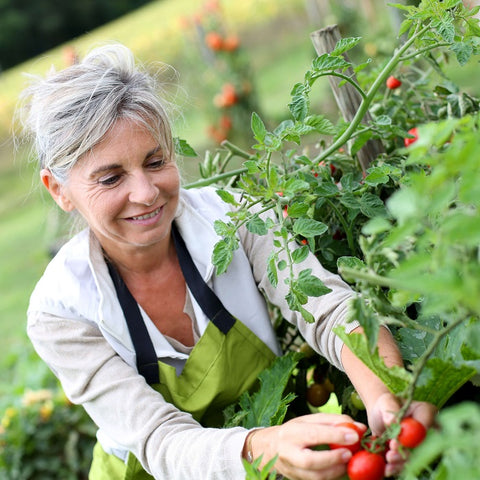Soil is often thought of as the boring part of gardening. While garden soil is never going to be as fascinating or interesting as choosing plants, the whole world beneath your feet is the foundation of your garden. New gardeners are admonished to invest money and effort in improving the soil before they even think about planting, but few appreciate the wisdom they hear until they see their new plants struggling to survive and needing more and more food and water. In organic gardening, you learn to feed the soil and let the soil feed the plants. However, it maintains a community of insects and microbes. The reason for adding extra organic matter to the soil is to provide food for beneficial microorganisms that release nutrients into the soil as they break down the organic matter. Earthworms and other soil-dwelling insects ventilate the soil as they move through it and contribute more organic matter through their waste and decomposition. This creates what is called healthy soil. The following content also has some reference value for raised garden beds.
Pesticides sprayed on plants get into the soil and kill the insects and microbes that live there. Synthetic fertilizers contain salt, which also kills the inhabitants of the soil and builds up in the soil, causing harm to the plants you are feeding. And synthetic fertilizers do nothing for soil fertility.
When discussing soil, it depends on four things: texture, structure, pH, organic matter, and fertility.

Soil texture
Soil texture refers to the size of soil particles.
Sand: Sand has the largest particles and is irregularly shaped. That's why the sand feels smooth and why it drains well. Sand is not easily compacted.
Silt: Silt particles are much smaller than sand, but still irregular in shape.
Clay: Clay has microscopic sized particles that are almost flat. Clay builds up easily, leaving little room for air or water to flow.
Sandy loam: Sandy loam is considered ideal garden soil and consists of a mixture of three basic textures. However, don't run out and buy sand to add to the clay and vice versa. Mix sand with clay and you'll get cement. The equation is not just about balancing soil texture.
Soil structure
Soil structure refers to the way the soil is held together. You can usually determine what your texture is by testing your structure. Take a handful of wet earth and shape it into a ball in your hand. If you poke the ball lightly with your finger and it cracks, it's probably sand. If the pressure is any higher, it will cause silt. If it's still there after you fiddle with it, you're getting mostly clay. To get a more accurate idea of the percentage of each texture in the soil, try this simple experiment.
Good soil structure is fragile. This allows the roots of the plant to work in it, air to pass through and water to drain out, but not so fast that the plant cannot enter. If you want to test how well your soil drains, try a penetration test.
There are two basic ways to improve soil structure, and they complement each other.
You can loosen the soil structure by tilling, and sometimes this is necessary. But farming breaks up the soil and kills the insects that live there. So regular farming is not the best option.
Another option is to add organic matter, which can improve any type of soil. Compost, leaf rot, and manure are all organic matter that rots. They make the soil soft and fertile and provide food for the insects that live in the soil.
Soil pH value
Soil pH is a measure of soil acidity (acidity, below 7.0) or alkalinity (sweetness, above 7.0), with 7.0 being neutral. Most garden plants prefer a pH in the neutral range. Some plants have more specific needs. Lilacs and clematis thrive in the sweet soil. Rhododendrons and blueberries prefer a lower pH. You can adjust the pH in different places.

In general, if your plants are growing healthily, your pH is probably fine. If your plants have nutritional problems, or are not growing well, it is worth testing your pH. If the pH of the soil is not in the acceptable range for the plants you are growing, they will not get the nutrients in the soil no matter how much you feed them.
You can buy a variety of pH testers at garden centers. You can also bring a sample to your local cooperative extension office for testing for a nominal fee. Once you know what your pH level is, you can start adjusting it slowly. You add some form of lime to raise the pH, and some form of sulfur to lower it. What type and how much depends on your soil and test results. Your extension reports and most testing tools will tell you what to do when you get the results.
Adding lime or sulfur to change soil pH is not a quick fix. It can take months to record changes in pH, and you'll need to periodically retest the soil to make sure it doesn't return to its original pH. Sometimes it's easier to simply change your plants to fit your pH.
Organic matter
Organic matter has many benefits for the garden, and you must make good use of it. There is no organic gardening without organic matter. Decaying organic matter is the food for plants in nature. Unfortunately, most gardeners tend to remove any dead plant material that falls on the lawn. It is very beneficial to let fallen leaves fall with the wind into the bush, where they not only nourish the soil, but also prevent erosion and cover the soil.
Adding organic matter to garden soil can improve soil structure and provide nutrients for microorganisms and insects. The more beneficial microbes the soil supports, the fewer harmful ones will survive. Good people feed on harmful microbes, such as nematodes and certain native diseases. They also release nutrients into the soil when they die. So the more beneficial microbes in the soil, the more nutrients there are in the soil. And many kinds of organic matter add more nutrients to the soil.
Organic matter also contains acids that can make plant roots more permeable, improve their absorption of water and nutrients, and dissolve minerals in the soil, making them available to plant roots.
Organic matter type
compost
Compost is a typical representative of organic matter. Compost is any kind of decaying organic matter. You can make your own, or you can buy the whole bag. The finished compost looks like fertile soil because it is black, brittle, and has an earthy smell. When the compost cooking process is complete, weed seeds, fungal spores, and other undesirable elements that may enter the compost bin should no longer be viable. Compost can be added to your garden at any time, either as soil or as mulch or topdressing. While it is recommended that you remove perennial weeds, pesticide-treated materials, and diseased plants from the compost bin, almost all other forms of plant material are fair game, such as:
Grass clippings
leaf
Garden waste (weeding, heading and pruning)
Vegetable peel
Saw dust
straw
paper
fertilizer
Aged animal waste is an organic material with additional soil nutrients. Animal waste must be aged for six months to a year before it can be used in the garden. Fresh feces will burn your plants, may contain bacteria that can cause illness through contact, and it stinks. You can add fresh fertilizer to the compost pile and let it age there.

Cow dung, sheep dung, and chicken dung are the most popular varieties, but there are several others. Fertilizers that should be avoided due to the potential for disease in humans include cats, dogs, pigs, and humans.
Green manure. Green manure covered crops are planted to return them to the soil. Obviously, it would be more useful in a vegetable garden or tilling in a newly created bed without harming existing perennials.
Different green fertilizers have different advantages. Some plants, such as alfalfa, are grown for their deep roots to break and loosen compacted soil. Legumes, clovers and vetch plants are able to absorb nitrogen from the air and eventually release it into the soil through their roots. Clover is especially attractive to pollinators and beneficial insects if allowed to flower. All green fertilizers will suppress weeds and prevent erosion and nutrient loss in areas that would otherwise go unplanted. Once they are farmed and start to break down, they all help create a good soil structure and food for microbes. Common green fertilizers include annual ryegrass. Barley, buckwheat, clover, winter wheat and winter rye.
Soil fertility
The nutrients in the soil are the ultimate building blocks of a healthy soil. Just like people, plants need certain nutrients to grow and ward off disease. Organic fertilizers can be extracted from plants, animals or minerals, basically from the soil. Organic fertilizers are released slowly, which means the plants can be fed as needed. There was no sudden change in the composition of the soil, which could have impaired microbial activity.
Building healthy soil is an ongoing process. By making healthy soil a focus when starting your garden, you'll have a head start on creating a sustainable organic garden.









